
Trumpeter 1/350 HMS Eskimo
| KIT #: | |
| PRICE: | |
| DECALS: | |
| REVIEWER: | Frank Spahr |
| NOTES: |

| HISTORY |
16 ships were built for the Royal Navy and completed during 1938. These vessels as the most powerful fleet destroyers to this date were heavily commited in the war, and only four of them survived the war.
The design found the interest of other Commonwealth nations, and three Tribals were laid down in 1939 for Australia, with another four built for Canada on British yards during the war and yet another four built on Canadian yards, not all of which were completed during the conflict. Only one out of the 27 Tribals survives today, HMCS Haida in Hamilton, Ontario.
The vessels were modified during the war along the
lines of other Allied vessels. Communications suites and radar fit was updated
and improved. That led to changes in the masts and rigging. The foremast was
replaced by a lattice mast, and the main mast by a stump pole mast to carry the
vital HF/DF receiver. Their AA capability was also improved; a major flaw in the
design had been to limit the elevation of the 4.7 inch guns to just 40°, which
made them useless as dual purpose guns. To remedy that, X turret was frequently
replaced by a twin 4 inch dual purpose mount. The two quadruple Vi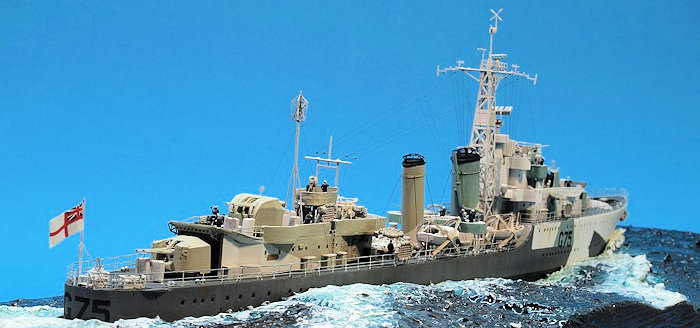 ckers .5 inch
machine guns were inferior in performance, so over the course of time, 20 mm Oerlikon mounts replaced existing guns and additional were mounted.
ckers .5 inch
machine guns were inferior in performance, so over the course of time, 20 mm Oerlikon mounts replaced existing guns and additional were mounted.
Whereas the British vessels were scrapped soon after the war, the Canadian and Australian ships saw longer service and postwar modifications for the new A/S role. The Canadian tribals served into the 1960s, until they, too, were sold for scrap.
HMS Eskimo was one of the few British Tribals to survive the war, despite several close shaves. She was torpedoed in the Rombaksfjord off Narvik in 1940 by the German destroyer Georg Thiele, losing her bow and many of her crew. She was towed to the UK and repaired; this occasion was also used to replace X mount as described above. After hard winter service in the Arctic seas, she had a refit during which her aft funnel was shortened, her main mast removed and radar installed.
After more service in the Arctic on varied operations she had another refit when her radar was updated, HF/DF installed and the AA fit augmented. In 1942 she operated both in the Mediterranean and the Arctic, participating in the Arctic convoy PQ 18 / QP 14, the Pedestal convoy to Malta and the Operation Torch landings in North Africa.
More arduous service in the Mediterranean followed in 1943. During Operation Husky, the invasion of Sicily, she was seriously damaged by German dive bombers. A complete refit in the UK followed emergency repairs made in Malta. During this refit she received the new lattice foremast and finally the replacement of the quadruple .5 inch machine guns. After the Normandy landings, Eskimo was employed in the Channel. She helped sink U 971 and was damaged in a gunfight with German minesweepers in late June.
Only a few days later she collided with HMS Javelin, which necessitated fitting another new bow, a major repair that lasted until November, 1944. She was then transferred to the British Pacific Fleet, where she served from February, 1945 until the end of hostilities. After her return to the UK she was soon reduced to an accomodation ship and then placed in reserve. Like so many other RN vessels, she was scrapped in 1949.
| THE KIT |
This kit is a typical Trumpeter offering. It is
produced to the highest current standards of injection molding, utilizes slide
molding in a helpful way and has really crisp detail. The torpedo tubes, to name
just one item, are just excellent. The downside is an inconsistent level of
research. There are various really annoying and visible, and - above all -
avoidable inaccuracies. Those really made the scale modeling community shake
their heads and wince. These gaffes were even more painful as this kit had been
preceded by a 1:700 version more than a year before. The 1:700 kit had dis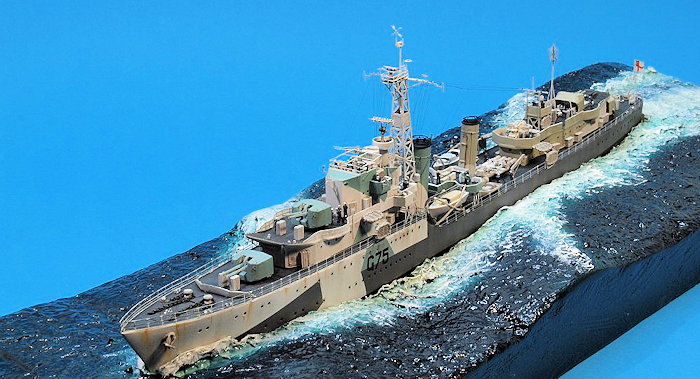 played
all the same flaws. They had been duly named in reviews and widely discussed at
the time. So it was more than a small surprise when they had not been rectified
in the later offering.
played
all the same flaws. They had been duly named in reviews and widely discussed at
the time. So it was more than a small surprise when they had not been rectified
in the later offering.
The most annoying mistake is the lack of sheer to the forecastle, which looks wrong compared to the real ship. Moreover, the shipīs boats are not British designs, but German. The Pom-Pom is the eight-barreled version which could not be fitted to destroyers for weight reasons. And the four-inch twin mounting that replaced X-mounting rather early on in the war is also missing.
So I was not surprised when a fellow modeler spotted me just having bought the kit at a show, made the sign of the evil eye and just sad: "Bad kit! Bad kit!"
Well, I had my reasons for buying the kit. I had received the WEM PE set to review, and that wouldnīt really do without a kit. Later on, and luckily right before WEM closed its UK operations, I also received their requisite additional sets, comprising the boats and the 4.7 and 4 inch gun mounts. The only thing missing was the quadruple Pom-Pom. Finding a replacement seriously delayed writing this review. More about that later.
As I was not overly happy with the all PE Oerlikons WEM offered, I decided to use the Master items which have machined brass for the mount and the barrel.
I very early on decided to build Eskimo in her late war fit, after the Sicilian damage, as she appeared from April, 1944 on. That also necessitated checking up on her paint scheme. This was the Emergency Fleet Scheme for destroyers, a comparatively simple scheme of four shades, applied to both sides of the ship the same way. I followed the description in my old Warship Perspective booklet by Alan Raven, but had quite some thinking and experimenting to do to find acrylic equivalents.
| CONSTRUCTION |
The WEM PE set is most helpful in that it contains parts for either early or late fits, has nameplates for all the Tribals, and contains useful hints on how to accurize the kit. I duly started by following their recommendations on correcting the missing sheer. This involves raising the first 47 mm of the forecastle deck by 2 mms at the bow and fairing that in, plus relocating the hawsepipes. I was able to shave the raised hawsepipes off without damaging them, but would have appreciated a PE replacement. The hawsepipes were then relocated upwards and the opening drilled out.
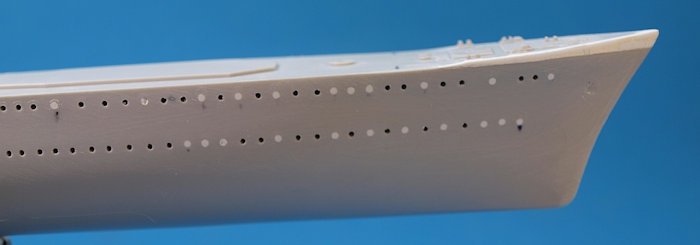 If you compare the kitīs scuttles with period
images, youīll realize that they donīt match with the period after Eskimoīs bow
had to be replaced. So I marked the surplus scuttles on the hull and filled them
with round styrene stock. After curing, the excess was removed and all the
remaining scuttles drilled out to a uniform diameter. I did not replace the
"eyebrows" but decided to hint at their presence by lightly penciling them after
painting.
If you compare the kitīs scuttles with period
images, youīll realize that they donīt match with the period after Eskimoīs bow
had to be replaced. So I marked the surplus scuttles on the hull and filled them
with round styrene stock. After curing, the excess was removed and all the
remaining scuttles drilled out to a uniform diameter. I did not replace the
"eyebrows" but decided to hint at their presence by lightly penciling them after
painting.
The deckhouses were assembled at that point, too, and as many subassemblies as possible tackled simultaneously.
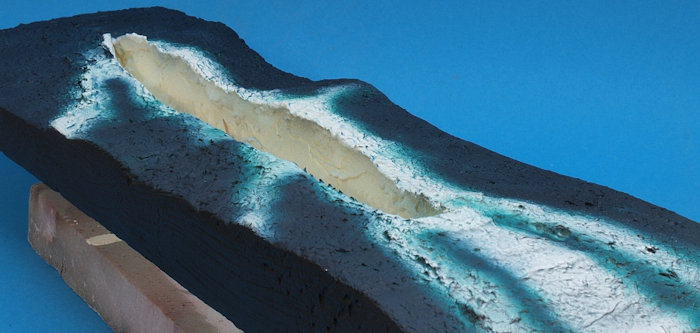 Once the hull correction was completed, the hull
was primed, sanded and re-primed. It was then coated with masking tape and
placed into a cutout I had made in a conveniently sized piece of 30 mm foam
board. That had been carved to the desired sea state previously. Remaining gaps
between the hull and the base were then filled with generic acrylic filler from
the hardware store and let cure. After that, I was able to remove the model and
continue work on the base unhindered by the ship.
Once the hull correction was completed, the hull
was primed, sanded and re-primed. It was then coated with masking tape and
placed into a cutout I had made in a conveniently sized piece of 30 mm foam
board. That had been carved to the desired sea state previously. Remaining gaps
between the hull and the base were then filled with generic acrylic filler from
the hardware store and let cure. After that, I was able to remove the model and
continue work on the base unhindered by the ship.
The base was prepared per my usual method, using white wall paint to seal the foam board and give it the required surface texture, and then add colour by spraying first green and then dark blue, both Vallejo paints.
| COLORS & MARKINGS |
The hull then was painted with hull red, a black
boot topping, and the various camouflage shades I had decided on. It was a
convoluted matter of looking through references, paint equivalent charts,
looking at 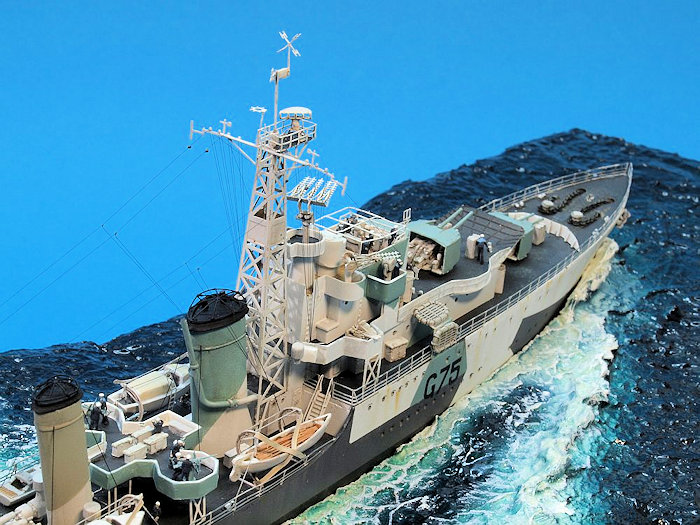 other models, at period images, of discussing the issue with a fellow
modeler to arrive at choices for each shade.
other models, at period images, of discussing the issue with a fellow
modeler to arrive at choices for each shade.
I needed a credible intensity of grey for the darkest hull colour G 20, also in comparison with the deck grey, and credible tonal shades for the B 30 and G 45 which comprised the remaining shades together with pure white. I ended up using Vallejo ModelAirīs equivalent for RLM 65 for the B 30, and their Light Grey Green had to stand in for G 45. As always, any other modeler researching the shades and deciding on their interpretation may arrive at differing results, which is perfectly understandable.
Masking and painting went surprisingly well, the hardware store spray can primer held up excellently on the plastic without any liftoffs.
|
CONSTRUCTION CONTINUES |
In building the various deckhouses, I mostly used the WEM PE parts save in the very nicely done bridge interior, where Trumpeter supplies a very nice bridge floor and windscreen, plus a delicate awning framework. I also preferred Trumpeterīs funnel grilles over the WEM items. Having all parts on one fret seems to have necessitated using thicker stock, so some of the WEM parts are a bit on the thicker side than necessary.
After long and careful deliberation, I added splinter screens to the aft deckhouse made from thin styrene stock, but I easily can be wrong here. Some generic Lion Roar PE was also used, namely the "Perforate Bars" to be used as stringers under the deckhouse extensions.
 After basic assembly, all the superstructure parts
were painted in camouflage, the demarcations being frequently checked to make
sure everything lined up properly.
After basic assembly, all the superstructure parts
were painted in camouflage, the demarcations being frequently checked to make
sure everything lined up properly.
I spent quite some time assembling the PE lattice mast and the various directors and radars. The main mast looked too weak and flat as a PE part, so I replaced it with machined brass.
The WEM replacement gun turrets with brass barrels are cast incredibly thin, and need extra care in assembly. How to fit the gun into the shield takes quite some checking and fitting and rechecking, but the end result is worth the effort. I had to read up on RN instructions as to how deck fittings and insides of gun shields were to be painted, and of course to make sure each gun mounting received the correct camo shade. Virtually all deck fittings had to be painted white, which looked quite crisp and trim to me.
The 20 mm Oerlikons by Master are incredibly detailed and just look the part when completed, but are seriously fiddly to work with. From my memory when building HMS Warspite with the Pontos equivalent I think those were easier to work with, but looked just as well.
The boats were cleaned up, received some basic additional PE and were painted a light grey.
All the parts were primed, painted and moderately weathered. I normally use a thin dark wash from Humbrol thinner and artistīs oil paint for the wash, and apply tiny spots of brown oil paint to the hull which I streak downwards with a Q-tip. Less is more, and the colours shouldnīt be too bright. Itīs easy in my perception to overdo things. It should also be noted which areas of a vessel are accessible for regular crew maintenance and which are only accessible in port.
The model was then progressively assembled, always
working from the centre to the periphery to reduce collateral damage. PE
railings were added after priming them. The horizontal wires on the railing were
hand painted in a darker grey, whilst the railing stanchions were left in white.
Canvas dodgers were hinted at using white glue and paint. Gaps around the
railings were filled with CA glue. Quite a lot of paint
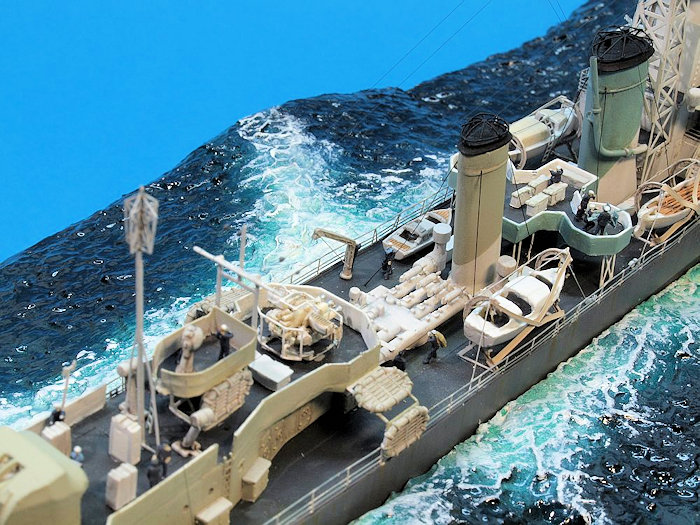 touchups were needed,
until I was able to add a flat coat. Crew figures were supplied by NorthStar,
their excellent 3D rendered figures are currently the best items Iīm aware of.
The ship was rigged with UNI caenis monofilament, always use the thinnest
available material for a credible look. A White Ensign from the decal sheet was
applied to aluminum foil, shaped as desired, and added to the flagstaff. When
the vessel was assembled, crewed and rigged, a final flat coat sealed things up.
The vessel was then placed on its base and put into its display box, at which
point I had to wait for the missing four-barreled Pom-Pom to arrive.
touchups were needed,
until I was able to add a flat coat. Crew figures were supplied by NorthStar,
their excellent 3D rendered figures are currently the best items Iīm aware of.
The ship was rigged with UNI caenis monofilament, always use the thinnest
available material for a credible look. A White Ensign from the decal sheet was
applied to aluminum foil, shaped as desired, and added to the flagstaff. When
the vessel was assembled, crewed and rigged, a final flat coat sealed things up.
The vessel was then placed on its base and put into its display box, at which
point I had to wait for the missing four-barreled Pom-Pom to arrive.
I had set my sights on the announced new North Star offering, which look mouthwateringly brilliant in the CAD renderings I had seen. Sadly, production and delivery of the item seemed to be delayed. To complicate things, the WEM item was out of production and listed in no webshop I was aware of. So, three months after Eskimoīs completion, I was browsing through the new LīArsénalīs website for my next project, when I found a 1:400 four-barreled Pom-Pom by Niko models of Poland, which I ordered speculatively. I had experienced various aftermarket items being a bit smaller or larger than their announced scale before, so I was willing to give it a try. The Niko item consists of two resin and about half a dozen PE parts, and is admittedly on the smaller side, but looked all right enough for this bear of little brain, so it was assembled, painted, lightly weathered and mounted aboard my Eskimo. Which enabled me to finally complete this review.
| CONCLUSIONS |
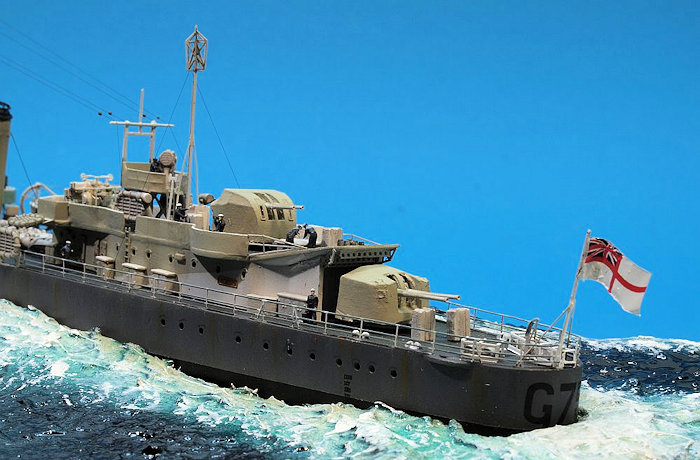 Thereīs a section on Graham Nortonīs Saturday
morning radio show called: "I canīt believe itīs not better!" Well, that about
sums up things for me. I am quite happy with the completed model as it sits in
its display box. But to produce a kit with these really visible and avoidable
flaws was really unnecessary. You need to scrounge together aftermarket items
some of which are really hard to get to achieve a good result, when just
listening to the modelers this kit concerns would have made this a virtual
shakeīn bake kit with exceptional detail. The skills and technology are there,
itīs just a matter of research and listening to those promoting the hobby on the
web and in print.
Thereīs a section on Graham Nortonīs Saturday
morning radio show called: "I canīt believe itīs not better!" Well, that about
sums up things for me. I am quite happy with the completed model as it sits in
its display box. But to produce a kit with these really visible and avoidable
flaws was really unnecessary. You need to scrounge together aftermarket items
some of which are really hard to get to achieve a good result, when just
listening to the modelers this kit concerns would have made this a virtual
shakeīn bake kit with exceptional detail. The skills and technology are there,
itīs just a matter of research and listening to those promoting the hobby on the
web and in print.
Aftermarket: PE set WEM PE 35169 , correct shipīs boats and props (25ft Motor Boat, 25ft Admiralty Motor Cutter and 27ft Whaler ) WEM PRO 3534, Four barreled Pom-Poms by Niko models, item ZW 4006 on LīArsénalīs website, 4 inch twin mount QF Mk.XVI, mounting HA Mk.XIX WEM PRO 3533, 4,7 inch twin mount WEM PRO 3535, and 20 mm Oerlikon (3 single mounts) Master NW 35052
March 2016
Copyright ModelingMadness.com
If you would like your product reviewed fairly and fairly quickly, please contact the editor or see other details in the Note to Contributors.